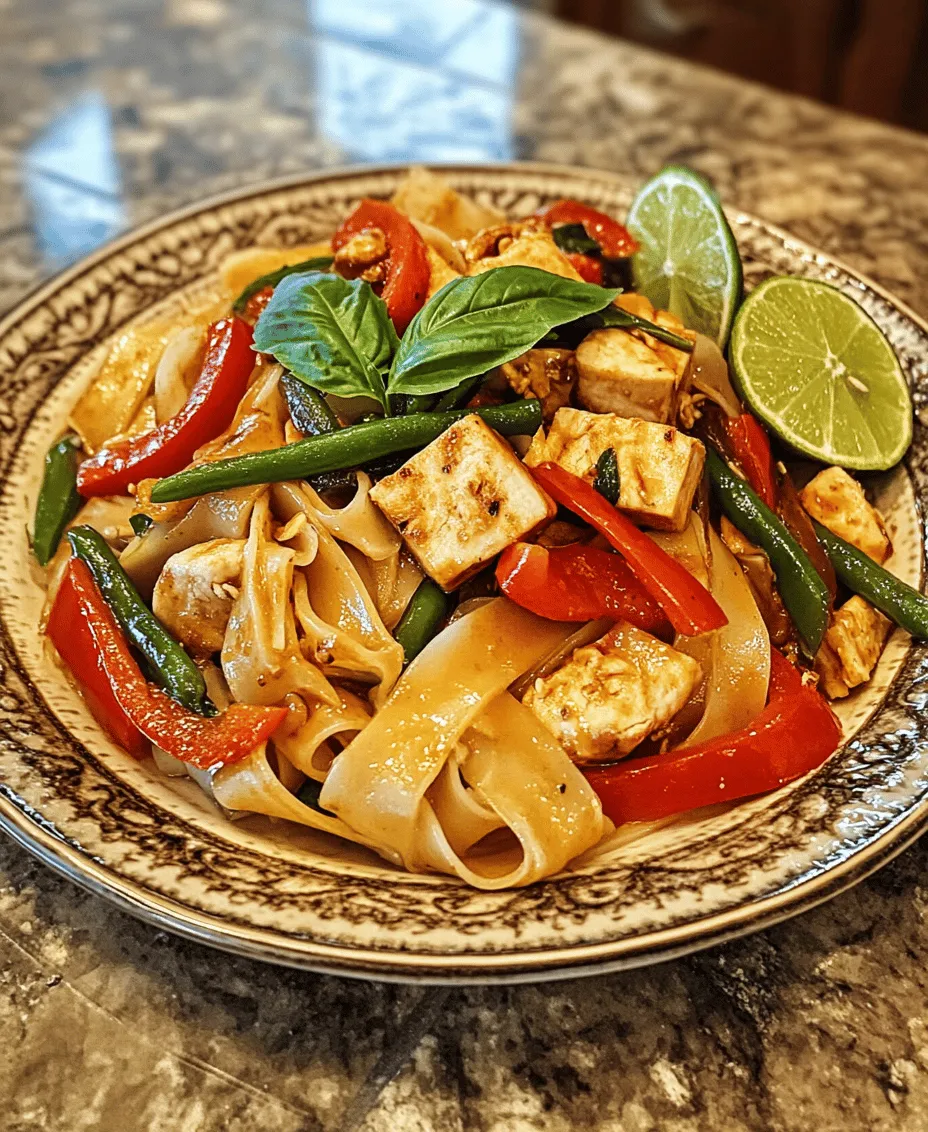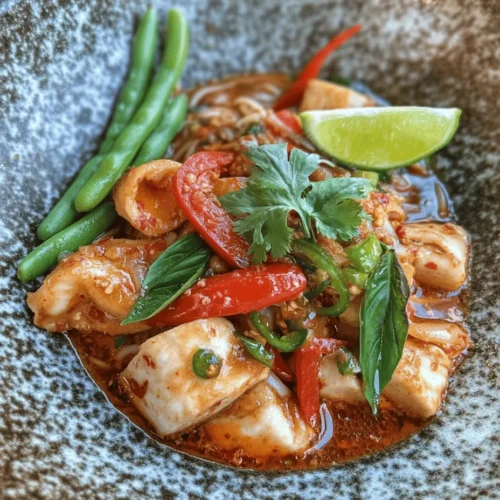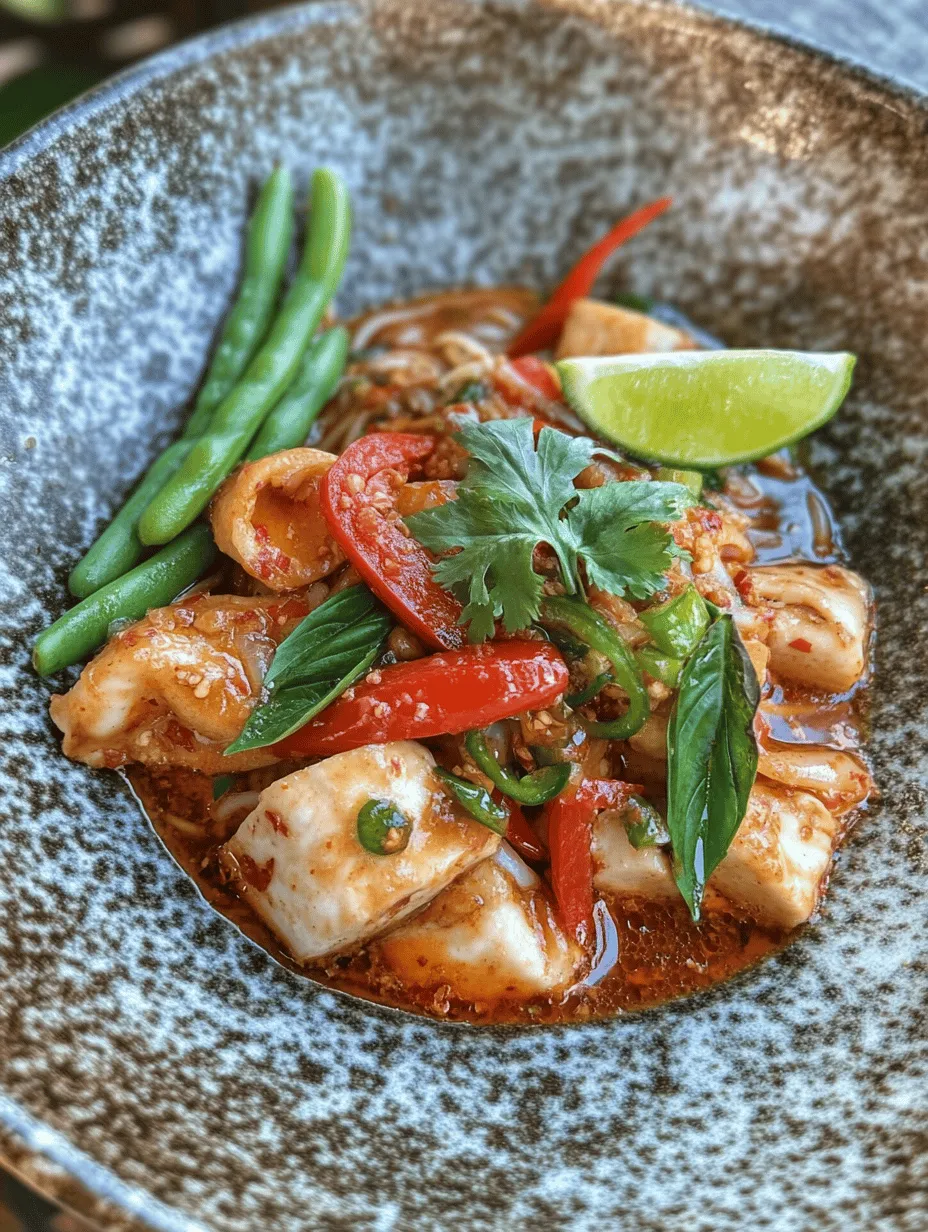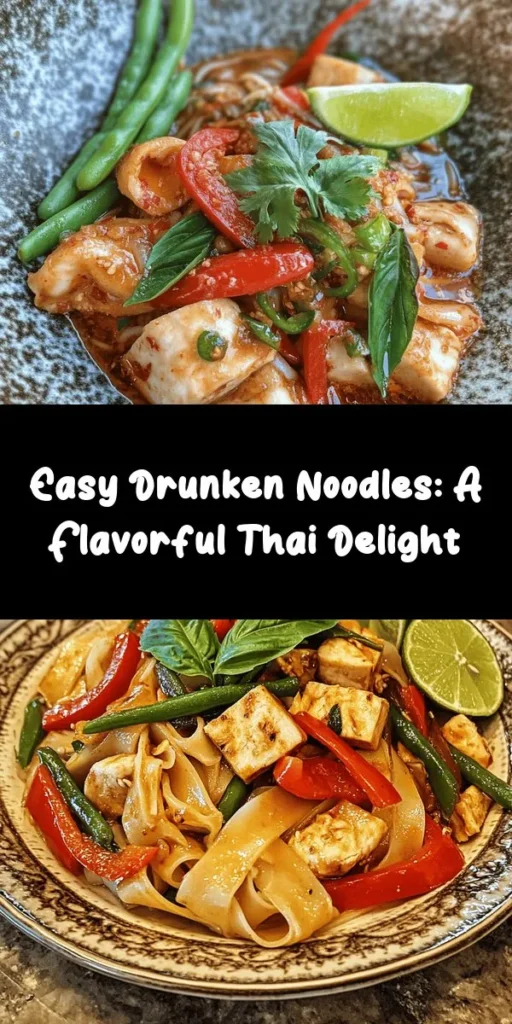Introduction
Drunken Noodles, known in Thailand as “Pad Kee Mao,” is a beloved dish that perfectly embodies the vibrant flavors and culinary traditions of Thai cuisine. This stir-fried noodle dish is a harmonious blend of wide rice noodles, fresh vegetables, aromatic herbs, and a choice of protein that creates a delightful medley in every bite. Often served with a spicy kick, Drunken Noodles is favored for its balance of savory and slightly sweet flavors, making it a popular choice among street food vendors and home cooks alike.
What makes Drunken Noodles particularly appealing is its versatility. The dish can be customized with various proteins, including tender chicken or plant-based tofu, catering to both meat lovers and vegetarians. This adaptability, along with its quick cooking time of under 30 minutes, makes it an ideal meal for busy weeknights or an impromptu gathering with friends.
In this article, you will learn to prepare Drunken Noodles Delight, showcasing how to bring the bold taste of Thailand into your kitchen. From understanding the rich history of this dish to mastering its key ingredients, we will guide you step-by-step through the preparation process, ensuring you create a delightful dish that impresses your family and friends.
Understanding Drunken Noodles
Origins of Drunken Noodles
Drunken Noodles has a fascinating backstory that dates back to the streets of Thailand. The name “Pad Kee Mao” translates to “stir-fried drunken noodles,” and while there are various theories about its origin, one popular belief suggests that it was a late-night dish enjoyed by revelers returning from a night out. The dish’s combination of bold flavors and hearty ingredients is said to help alleviate the effects of overindulgence, providing a satisfying meal that can soak up the excesses of a night of partying.
The roots of Drunken Noodles can also be traced to the broader cultural significance of street food in Thailand. Street vendors play a crucial role in Thai culinary culture, offering quick, affordable, and delicious meals that reflect the country’s diverse regions and traditions. This dish, with its origins in the bustling streets of Bangkok and beyond, has become a staple that resonates with both locals and travelers alike.
The Significance of the Dish in Thai Street Food Culture
In Thailand, street food is more than just a quick meal; it is an integral part of the social fabric. Drunken Noodles is often found on the menus of food stalls and restaurants across the country, showcasing the vibrant street food scene that attracts millions of visitors each year. The dish’s popularity is attributed to its bold flavors, generous portions, and the ability to cater to various tastes and dietary preferences.
When you enjoy Drunken Noodles from a street vendor, you’re not just savoring a meal; you’re experiencing a slice of Thai culture, where food brings people together. The lively atmosphere of street markets, filled with sizzling woks and the enticing aroma of spices, creates a memorable dining experience that is hard to replicate in a standard restaurant setting.
Variations Found in Different Regions of Thailand
While Drunken Noodles is widely recognized throughout Thailand, each region has its unique take on the dish, influenced by local ingredients and culinary traditions. In northern Thailand, for example, you might find variations that incorporate more fresh herbs and spices, while southern versions may lean towards a spicier profile, featuring an abundance of chilies.
The use of protein can also vary based on regional preferences. In tourist areas, you may find a more extensive selection of proteins, including seafood, while locals might prefer traditional options like chicken, pork, or tofu. Additionally, the type of vegetables used can change based on seasonal availability, further enhancing the dish’s adaptability.
Ingredients Breakdown
To create the ultimate Drunken Noodles Delight, you’ll need to gather a selection of fresh ingredients that play a crucial role in achieving the dish’s signature flavor and texture.
Wide Rice Noodles
At the heart of Drunken Noodles are the wide rice noodles, which provide a chewy and satisfying base for the dish. These noodles are made from rice flour and water, giving them a gluten-free quality that appeals to many diners. Their flat shape allows them to absorb sauces and flavors beautifully, ensuring that every bite is packed with deliciousness.
When selecting rice noodles, look for the wide variety, often labeled as “Pad Thai noodles” or “sen yai.” These noodles cook quickly and hold up well in stir-frying, making them the perfect choice for this dish. A quick soak or boil before cooking will help achieve the ideal texture.
Vegetables
Fresh vegetables are essential to adding color, texture, and nutrients to Drunken Noodles. Common choices include bell peppers, carrots, and onions, which provide a satisfying crunch and a medley of flavors. Garlic and shallots are often sautéed at the beginning to create an aromatic base, while leafy greens like Chinese broccoli or bok choy can be added for extra nutrition.
Using seasonal and fresh produce not only enhances the flavor profile of the dish but also contributes to its visual appeal. The vibrant colors of the vegetables make Drunken Noodles not only delicious but also a feast for the eyes.
Thai Basil
One of the standout ingredients in Drunken Noodles is Thai basil, a fragrant herb that adds a unique flavor profile to the dish. Unlike sweet basil commonly found in Western cooking, Thai basil has a slightly spicy, peppery taste with hints of anise. This herb becomes aromatic when cooked, infusing the dish with its distinctive essence.
Thai basil is often added at the end of cooking to preserve its flavor, and it pairs exceptionally well with the savory sauces and other ingredients in the dish. If you can’t find Thai basil, you can substitute it with regular basil, but the flavor won’t be quite the same.
Sauces
The sauce is where the magic truly happens in Drunken Noodles. A combination of soy sauce, oyster sauce, and sometimes a hint of fish sauce creates a rich, savory base that clings beautifully to the noodles. Soy sauce provides saltiness, while oyster sauce adds depth and sweetness, balancing the dish’s overall flavor.
For those seeking vegetarian or vegan options, there are excellent alternatives available. Vegetarian oyster sauce made from mushrooms can be used in place of the traditional oyster sauce, while soy sauce remains a staple for umami flavor. Additionally, a splash of lime juice can elevate the dish, providing a refreshing acidity that cuts through the richness of the sauces.
Protein Options
Drunken Noodles can be customized with various protein choices, making it a flexible dish suitable for meat eaters and vegetarians alike. Chicken is a popular option, offering a lean source of protein that absorbs the flavors of the sauce well. Alternatively, tofu is an excellent choice for those looking for a plant-based protein option. Firm or extra-firm tofu holds up well during cooking and can be marinated for added flavor.
Regardless of the protein you choose, the cooking method remains the same. Both chicken and tofu can be sautéed until cooked through before being added to the noodles, ensuring that each component melds together beautifully.
Preparation Steps
Now that we’ve explored the history, significance, and ingredients of Drunken Noodles, it’s time to dive into the preparation steps. Follow this comprehensive guide to ensure your Drunken Noodles Delight turns out perfect every time.
Preparing the Rice Noodles
To start, you’ll need to prepare the wide rice noodles. Begin by soaking them in warm water for about 30 minutes or until they are pliable but not fully cooked. This pre-soaking helps to soften the noodles, ensuring they cook evenly during stir-frying.
Once soaked, drain the noodles and rinse them under cold water to prevent sticking. Toss them with a splash of oil to keep them from clumping together, and set them aside while you prepare the other ingredients.
Sautéing Aromatics
Next, heat a large wok or skillet over high heat and add a generous amount of oil. Once hot, add minced garlic and shallots, stirring quickly to release their fragrant aroma. The key to sautéing aromatics is to avoid burning them, so keep the heat high and stir constantly.
After the garlic and shallots become fragrant, add your protein choice—sliced chicken or cubed tofu. Cook until the protein is browned and cooked through, which should take about 5-7 minutes. This step ensures that the flavors meld together and the protein absorbs the aromatic essence of the garlic and shallots.
Cooking Vegetables
Once the protein is cooked, it’s time to add the vegetables. Start by adding sliced bell peppers and onions, stirring frequently to maintain their crispness. The goal is to cook the vegetables just until they are tender but still retain some bite. This method preserves their vibrant colors and nutritional value.
After a couple of minutes, add any leafy greens you choose, such as Chinese broccoli or bok choy, allowing them to wilt slightly before moving on to the next step. The combination of cooked and fresh vegetables adds layers of texture and flavor to your Drunken Noodles Delight.
—
This introduction and preparation guide serves as a foundation for your Drunken Noodles Delight experience. In the next part of the article, we will delve deeper into the final steps of cooking the noodles and assembling the dish, ensuring that you achieve the perfect balance of flavors and textures. Stay tuned for an exciting culinary adventure that brings the essence of Thai street food right to your kitchen!

Incorporating Protein: How to Prepare Chicken or Tofu for Optimal Flavor
When it comes to Drunken Noodles Delight, the choice of protein can significantly enhance the dish’s overall flavor and texture. You have two popular options: chicken and tofu. Here’s how to prepare each to ensure they complement the vibrant flavors of the noodles and sauces.
For Chicken:
1. Choose the Right Cut: Opt for boneless, skinless chicken thighs for juiciness, or breast meat for a leaner option. Thighs generally provide more flavor and tenderness.
2. Marinate: To infuse the chicken with flavor, marinate it for at least 30 minutes in a mixture of soy sauce, oyster sauce, and a dash of sesame oil. Adding minced garlic and ginger enhances the taste.
3. Cooking Method: Heat a pan over medium-high heat with a little oil. Cook the marinated chicken for about 5-7 minutes, or until golden brown and cooked through. Avoid overcrowding the pan to achieve a good sear.
For Tofu:
1. Choosing Tofu: Firm or extra-firm tofu works best as it holds its shape during cooking.
2. Pressing: Drain the tofu and press it for about 15-20 minutes to remove excess moisture. This step is crucial for achieving a crispy texture when cooked.
3. Marinate: Similar to chicken, marinate the pressed tofu in soy sauce, a hint of lime juice, and a sprinkle of sugar to balance the flavors.
4. Cooking Method: Cut the tofu into cubes and sauté in a hot pan with a bit of oil until all sides are golden brown. This usually takes about 8-10 minutes.
Regardless of the protein you choose, the key is to ensure it is well-seasoned and cooked to complement the other ingredients in your Drunken Noodles Delight.
Mixing Sauces: Balancing Flavors with the Right Combination of Sauces
A hallmark of Drunken Noodles is its rich and complex sauce. The right balance of flavors is essential to achieving that perfect taste profile. Here’s how to mix your sauces effectively:
1. Base Ingredients: Start with soy sauce and oyster sauce as your primary bases. Soy sauce adds saltiness, while oyster sauce provides a sweet and umami flavor.
2. Sweetness: Incorporate a tablespoon of brown sugar or palm sugar to balance the savory notes, contributing to a well-rounded sauce.
3. Heat Factor: For that authentic kick, add a teaspoon or more of chili paste or sriracha, depending on your spice tolerance.
4. Citrusy Notes: A splash of lime juice at the end of cooking brightens the flavors and adds zest.
5. Mixing It Up: In a small bowl, combine these ingredients and whisk them together until the sugar dissolves. Taste and adjust as needed to suit your preference.
Once your sauces are prepared, you can integrate them into your dish seamlessly, ensuring an even distribution of flavors throughout the noodles.
Adding Noodles and Finishing Touches: Ensuring Even Coating and the Right Cooking Time for Basil
The noodles are the heart of this dish, so it’s crucial to cook and add them properly for an optimal experience. Here’s how to do it:
1. Cooking the Noodles: Start by boiling water in a large pot. Add flat rice noodles and cook them according to the package instructions, usually around 6-8 minutes. Aim for al dente as they will continue to cook later in the pan.
2. Draining and Rinsing: Once cooked, drain the noodles and rinse them under cold water to stop the cooking process. This step prevents them from becoming mushy.
3. Stir-Fry Process: In a large wok or skillet, add your sautéed chicken or tofu, followed by the cooked noodles. Pour in your sauce mixture and toss everything together. Use tongs or a spatula to ensure the noodles are evenly coated.
4. Adding Basil: One of the finishing touches is the addition of fresh Thai basil. Add it just before serving to preserve its aromatic qualities. Stir it in and let the residual heat wilt the leaves slightly without overcooking them.
By following these steps, you’ll create a dish where every ingredient shines, culminating in a delightful Drunken Noodles experience.
Nutritional Information
Understanding the nutritional profile of Drunken Noodles Delight can help you make informed decisions about portion sizes and dietary needs. Here’s an overview:
Caloric Content and Portion Sizes:
– A typical serving of Drunken Noodles (approximately 1.5 cups) contains around 400-600 calories, depending on the protein choice and quantity of oil used. If you’re mindful of caloric intake, consider adjusting portion sizes or ingredients like oil and sugar.
Nutritional Benefits of Key Ingredients:
– Rice Noodles: Gluten-free and easy to digest, they provide carbohydrates for energy.
– Chicken: A lean source of protein that is rich in essential amino acids and vitamins, particularly B6 and niacin.
– Tofu: A great plant-based protein option, high in iron and calcium, making it suitable for vegetarians and vegans.
– Vegetables: Bell peppers, green beans, and Thai basil add fiber, antioxidants, and vitamins, contributing to your overall health.
Accommodating Dietary Preferences:
– For those following a gluten-free diet, use gluten-free soy sauce or tamari.
– Vegans can easily substitute chicken with tofu or tempeh, and still enjoy a hearty, satisfying meal.
Serving Suggestions
Presenting Drunken Noodles Delight in an appealing manner can enhance the dining experience. Here are some ideas:
Pairing with Side Dishes or Salads:
– Serve with a refreshing cucumber salad dressed with vinegar and a pinch of sugar to balance the flavors of the noodles.
– Spring rolls can also make a delightful appetizer, offering a crunchy contrast to the soft noodles.
Beverage Pairings:
– Pair your Drunken Noodles with a light, crisp beverage. Thai iced tea or a cold Singha beer are excellent choices to complement the dish.
– For non-alcoholic options, consider coconut water or a citrus-infused sparkling water for a refreshing balance.
Presentation Tips:
– Use a large serving platter for a communal feel, or present individual bowls garnished with lime wedges and extra basil for added color.
– Drizzle a little extra sauce over the top and sprinkle with sesame seeds or chopped peanuts for texture and visual appeal.
Variations and Customizations
Drunken Noodles Delight is versatile, allowing for personalization to suit individual tastes. Here are some options to consider:
Protein Alternatives:
– Feel free to mix it up with shrimp, beef, or pork for a different flavor profile.
– For a vegetarian twist, consider adding chickpeas or edamame for an additional protein boost.
Additional Vegetables:
– Incorporate seasonal vegetables like zucchini, baby corn, or snap peas to enhance the dish’s texture and flavor.
– Broccoli or bok choy can add a nutritious crunch and vibrant color.
Spice Levels:
– Adjust the level of spice by adding more or less chili paste based on your preference. For a milder flavor, omit the chili altogether or serve with chili flakes on the side for guests to customize their bowls.
Conclusion
Making Drunken Noodles Delight is not just about cooking; it’s about creating a flavorful experience that transports you to the heart of Thai cuisine. The combination of tender protein, savory sauces, and fresh vegetables melds together to produce a dish that is both satisfying and exciting. Whether you’re preparing a quick weeknight dinner or showcasing your culinary skills at a festive gathering, this dish offers something for everyone.
As you explore this recipe, take the opportunity to play with flavors and ingredients, making it your own. The vibrant tastes and aromas of Drunken Noodles Delight will undoubtedly leave a lasting impression on your palate and those you share it with. Enjoy the journey of cooking and savor the delightful flavors that make Drunken Noodles a standout dish in any meal.



